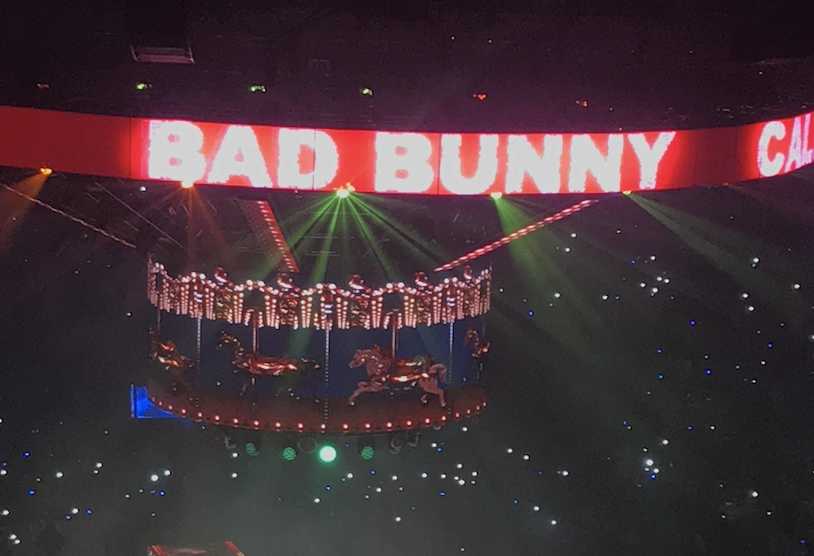Bad Bunny’s surprise 20-track album affirms one thing — he does what he wants and he wants to make that known. Titled “YHLQMDLG”, an acronym for “Yo Hago Lo Que Me Da La Gana” (I Do What I Want), there is no controlling Bad Bunny’s ambitious and erratic antics, but again, who would want to? The musician weaves through continents and genres in the same dembow-driven manner that won him a Latin Grammy only a year prior. This throwback reggaeton album is half party anthems and half cry-over-your-ex tracks and ultimately meant to get you out of bed and into a club.
In the midst of pulsing rhythms and explosions of clever, raunchy lines, Bad Bunny plunges into the history of reggaeton both in samples, characteristic beats and tastefully intentional collaborations. It is no secret that Bad Bunny admiringly pours his Puerto Rican pride into his music, and his features include fellow Puerto Ricans Daddy Yankee, Ñengo Flow and Yaviah.
Bad Bunny is never reluctant to croon about his feelings and “YHLQMDLG” opens with a song that leaves even the most apathetic listener with a heavy heart. “Si Veo a Tu Mamá” chronicles running into a lost love’s mom, where Bad Bunny, slurring, asks if her daughter is happy with someone else. Only Bad Bunny could pair these sentimental words amidst the playful world of video game sounds and an electrified Brazilian bossa nova flair.
While “Si Veo a Tu Mamá” plays to Bad Bunny’s sweeter, more dolent side, the bad of Bad Bunny is much more pronounced in other tracks. The bawdier part of reggaeton’s history is portrayed in grungier beats and more sinister, X-rated lyrics. “P FKN R,” “Está C-brón Ser Yo,” and “Puesto Pa’ Guerrial” are daunting, gritty and taunting.
“Safaera” is the golden child of Bad Bunny’s influence-fusing genius. A Russian nesting doll of songs, samples from founding, almost vintage reggaeton songs are interbred with Afrobeat cadences and Missy Elliot’s “Get Ur Freak On.” He creates songs within songs, with booming beats that repeatedly change and a promiscuously addictive chorus that contributes to the chaotic atmosphere of the most exclusive, raunchy club in town.
The surprises don’t stop there. Bad Bunny devises “Hablamos Mañana,” a synthetic flute-filled song with a stern backbeat holding its reggaeton roots with a hint of rock in Spanish. Wait until the last 45 seconds or so and he might have you believing you’re listening to the kind of music your dad would like. Headbanging drums, electric guitar and Bad Bunny screaming? I shouldn’t have been surprised, but I was.
Eventually, all parties must come to an end. Thankfully, this bittersweet end is comprised of Bad Bunny’s trembling voice in an ode to his fans, his country and his opportunities as the self-proclaimed “king of latin trap” in “<3.” This end is not exclusive to the album, as Bad Bunny precariously laments, “Y en nueve mese’ vuelvo y saco otro / Pa’ retirarme tranquilo como Miguel Cotto” (And in nine months I’ll come back and drop another / To retire peacefully like Miguel Cotto). Yes, you read that correctly. This song is also an allusion to Bad Bunny’s boredom with fame, which he describes later in the track as making him sick. But as “YHLQMDLG” flirts with Bad Bunny’s personal and imagined life, let’s hope this plan falls under the fictional category.
Each track on “YHLQMDLG” is anomalously unexpected, yet distinctly rooted in reggaeton roots and Bad Bunny’s melodramatic persona. Bad Bunny’s sophomore album parades his advancement as an artist in a global lens. His vocals are as extensive as ever, and his influences have never been wider. Bad Bunny knows he doesn’t need approval to do what he wants, and it suits him flawlessly. The question stands: how much farther can Bad Bunny go while remaining authentic to the reggaetonero we met in “Pa’ Ti?”
Email Ana Cubas at [email protected].























































































































































